Excerpts from Jim Conrad's
Naturalist Newsletter
from the April 12, 2019 Newsletter with notes from a camping trip into the Petén distric of northern GUATEMALA
PANAMA HAT PLANT
On March 31 during last month's camping trip into northern Guatemala's Petén district, in El Rosario National Park on the west side of the town of Sayaxché, I'd lost my trail through the forest and with my compass was navigating toward the highway. The compass was useful because clouds and a dense forest canopy hid the Sun. The going was rough through dense vegetation covering a very irregular, rocky limestone bedrock, so I had to watch every step or I'd blunder into a spiny palm or tumble into a sinkhole. With eyes on the forest floor, suddenly I saw the remarkable structures shown below:

I'd stumbled into a whole bunch of them and in some places numerous "cones" seemed to stretch toward sunlight, as shown below:
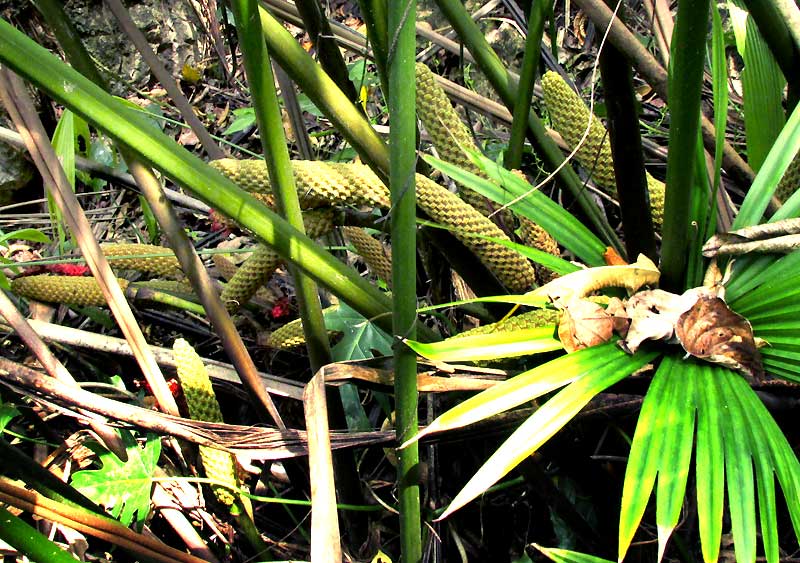
The foot-long "cones" looked like those of gymnosperms, of which pines and spruces may be the best-known members to northerners, so immediately I thought of cycads, which are palm-like gymnosperms of the tropics and subtropics. And the leaves did look like those of a palm of that group with fan-shaped leaves, as could be seen with the blades looming 10ft (3m) above the cones, shown below:
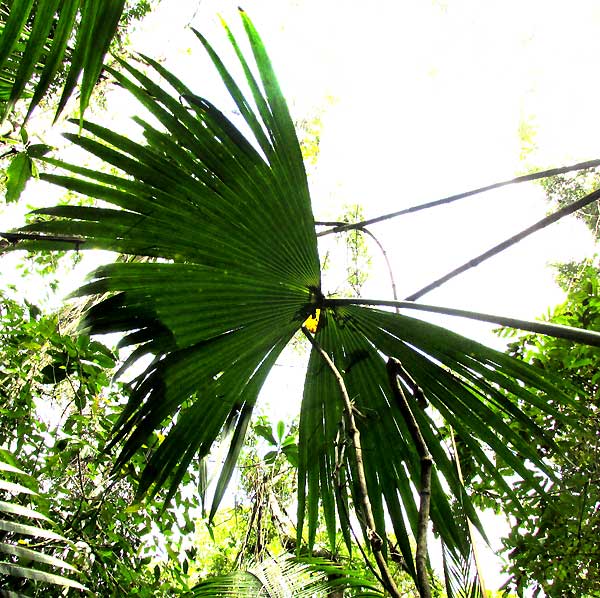
All the blades on plants around me were deeply split and tattered looking like that one, but upon reaching the campground I found some planted ones that had received plenty of sunlight and were watered from a roof's runoff, and those leaves displayed a more systematic parting: Usually they were divided nearly to the base in four or so main divisions, with the outer margin of each main division less deeply cut.
Once I began studying the situation, a problem developed with my cycad theory. On cycads, the leaves are pinnately compound, or feather-like, not palmately compound, like these. Also, no gymnosperm seems to have "cones" quite like these. And when I began looking closer at those "cones," they didn't look like gymnosperm cones at all, as evidenced by the close-up of a "cone's" surface shown below:
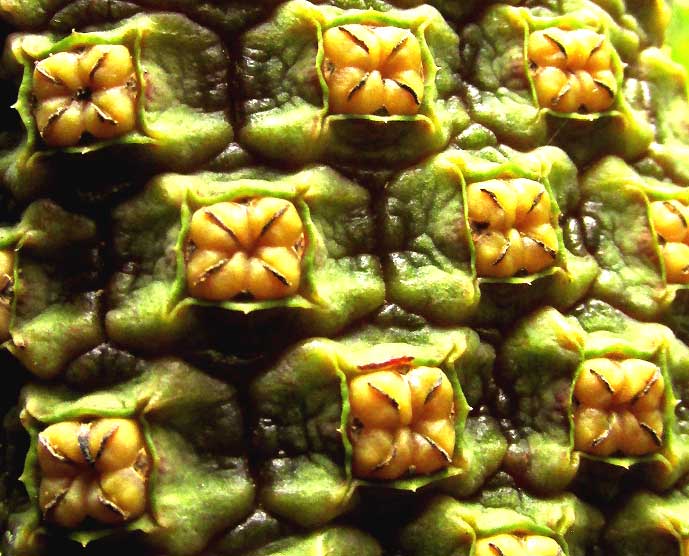
In a gymnosperm cone, a seed is borne naked on the surface of a single scale or modified leaf, as with the papery seed of a pine cone on the single woody scale or bract below it. Our picture shows something that could be a weird seed, but either each "seed" has four scales or bracts, or none. Looking around for more mature fruiting structures, one was found that had been nibbled on by an animal, resulting in what's shown below:
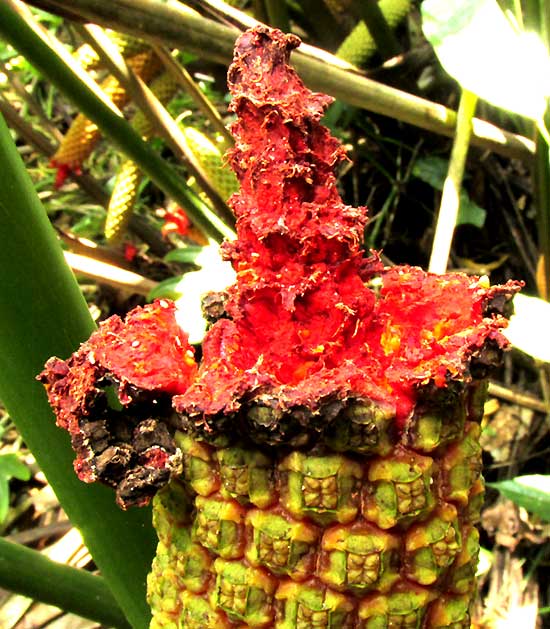
Cutting across a fruiting structure revealed the pretty and informative sight displayed below:
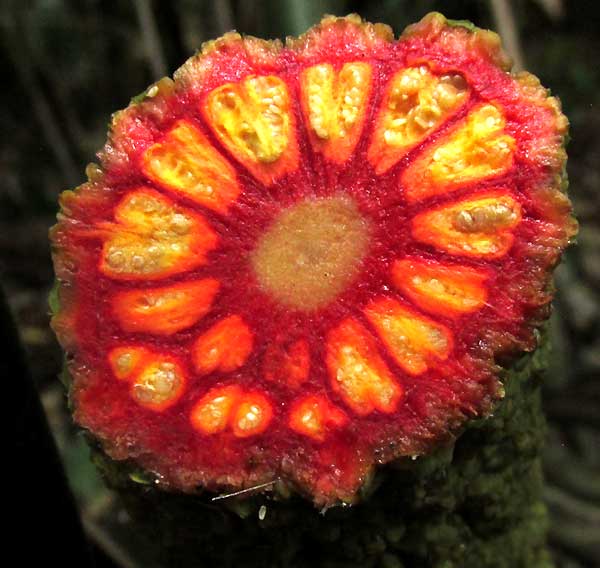
At first it looks like the cross section of an ear of corn, with yellowish corn kernels. However, the yellow things aren't seeds, like corn kernels. Notice that each yellow item has inside it numerous other tiny, white items. Those white items are the seeds. The yellow, kernel-like structures are tightly crammed-together fruits resulting from the matured ovaries of many separate flowers arranged along a spiky axis. All the yellow fruits are fused together into a "multiple fruit," the nature of which is made clear by my drawing online at www.backyardnature.net/frt_mult.htm
All these nice details still didn't ring a bell, for these plants so commonly occurring in El Rosario National Park belong to a plant family I'd simply forgotten about. I had to "do the botany" like a Botany 101 student to realize that here was a member of the Cyclanthus Family, the Cyclanthaceae -- native only to the American tropics -- and species in that family aren't gymnosperms, but rather are monocots, like with grasses, orchids and palms.
At the university I'd learned that in an evolutionary sense the Cyclanthus Family was transitional between the palms and the Arum Family, the Araceae (Jack-in-the-pulpit), which it certainly looks like. However, now genetic sequencing has revealed that similarities to those families are only superficial. The Cyclanthus Family is closely related to the Screw-Pine Family, the Pandanceae, native to the Old World tropics, mostly Malaya and the Pacific islands. The only other member of that family we've encountered has been the Screwpine, or Pandanus, often grown in tropical gardens, shown at www.backyardnature.net/yucatan/pandanus.htm
In our area, several members of the Cyclanthus Family occur, but having seen the fruiting structure's anatomy so clearly it was easy to determine that what we had here was CARLUDOVICA PALMATA, commonly known in English as the Panama Hat Plant. Back in the days when Panama hats were in vogue, they were made with fiber taken from this species' leaf stems, or petioles. The petioles are so slender, stiff and durable that I used them as walking sticks in rough territory. Panama Hat Plants are distributed from southern Mexico south through Central America to Peru.
Since forest animals eat the ripe fruits, I decided to take a bite myself. It was too bitter for me. I read that the fruits contain calcium oxalate crystals, which can give a sensation in the mouth of lots of small needles sticking into the flesh, but I didn't have that sensation, just the bitterness. I also read that young flowers, leaves and leafstalks as well as the rhizomes, can be eaten raw or cooked.